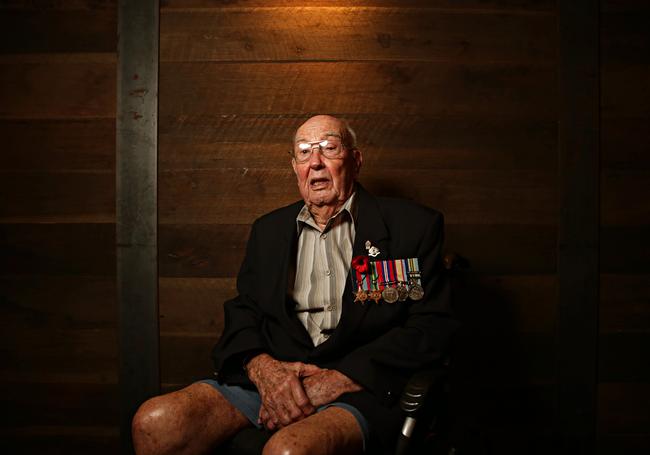Wal Williams can remember seeing the torpedo streaking through the water towards his ship.
The only thing he had time to say to his best friend Max Campbell before it hit its target was: “We’re history, mate”.
A few hours earlier the pair, along with 1300 other Australian POWs bound for Japan on the Rakuyo Maru, were woken when a ship in their convoy was blown up by a US submarine.
That ship, a Japanese cruiser, was hit around 2am, on September 12, 1944.
LISTEN TO WAL TELL HIS STORY
“One torpedo, bingo,” Williams told the Manly Daily from his home RSL LifeCare Narrabeen last week. “I’d say within two minutes it broke in half.” At the time Private Williams, 22, and his pal Able Seaman Campbell were trying to sleep on a heap of wooden rafts on the deck. After that they knew an attack on their ship was imminent.
At around 5.30am two tankers in the convoy were hit, going up in flames and spilling oil into the water.

The Rakuyo Maru was next. The first torpedo went straight into the engine room at around 5.30am. Williams saw the second one coming.
“It was coming through the water dead set where we were,” he said.
The ship rose on the waves as the second torpedo blew a hole in the front of it that was so big “you could have rowed a rowing boat through it” and causing a cascade of water to crash over them.

“This water that the torpedo sent up was like being in the surf and a dumper,” Williams said.
“It washed us clean off the top of these rafts and right in front of us were the winches … and if we had hit that that would have been the end of us, it would have stripped the skin straight off of us.”
The wave washed the clothes from their bodies, leaving them in just their underpants. The pair decided to jump ship. They found a flimsy raft to hold on to.
Others remained on board taking the opportunity to even old scores.
“One big bloke picked up a sword and chopped up about six Japs,” Williams said.
By about 6am there were hundreds of Australian and British POWs from a number of torpedoed ships in the water.
When Williams and Campbell found the current was taking them towards a burning mass of oil, they decided to swim back to the ship, which was about a mile away and still afloat
Halfway back the Japanese set off depth charges, designed to destroy submarines but which can crush the stomach of anyone unlucky enough to be in the water.

Campbell, having been in the navy, ordered the men to lie on their backs.
“The first one went off,’ Williams said. “Concussion comes through the water. You have no idea.”
Back on ship, Williams recalls a funny moment when his other good mate Bert Harper was trying to reassure a Korean prostitute on-board to service the Japanese, that everything would be all right.
“Bert was a bloke about 28 and we all looked upon him as an old man,” Williams said. “He was as bald as a badger. He had an AIF hat on and no clothing.
“I said, ‘Harper, have a look at yourself. You’re starkers’. ‘Oh my God,’ he said and he pulled his hat off and shoved them over his privates. Well, it was the funniest thing. I can still remember it all these years later.”

Williams, Campbell, and Harper all managed to get off the ship on to a lifeboat before the Rakuyo Maru sank.
It was a bittersweet moment when they were eventually picked up by a Japanese whaling boat. Many others in lifeboats who went in the opposite direction were never seen again.
Despite more attacks, the trio made it to Japan.
They were taken to a camp in Kawasaki and forced to work 10 days on, with one day off, with just boiled rice to sustain them.
That winter was the coldest ever experienced in Japan. “The only clothing we had was hessian, no warmth in it,” Williams said. “From your knees down all day you couldn’t feel yourself.”
That winter many men died from pneumonia including his best mates.

Harper died on February 19, 1945, and Campbell the following day. Somehow, Williams, who was also very sick, survived the winter and the devastating US air raids that obliterated both residential and industrial areas.
The day they found out the war had ended the POWs decided to celebrate by making an Australian flag from any bits of material they could cobble together. “You’d be surprised what blokes carry, I’ll tell you,” Williams said.
A tailor in the group stitched it together, and it was hoisted above their hut, much to the consternation of the Americans, who complained they had won the war not them. The Aussies held strong, although sadly the flag, pictured above, was lost en route to Australia.

Add your comment to this story
To join the conversation, please log in. Don't have an account? Register
Join the conversation, you are commenting as Logout
Class act! Top teen rugby stars to watch at Australian school champs
Weapons, speedsters, big units, a player with Joseph Suaalii athleticism and a ‘man boy’ - the rising stars to watch at the Australian schools rugby championships. FULL TEAM LISTS
Plans approved for 124-unit block close to busy Sydney hospital
Plans have been approved for one of the first big ticket apartment redevelopments on the edge of a new town centre in Sydney. See the artist’s impressions.